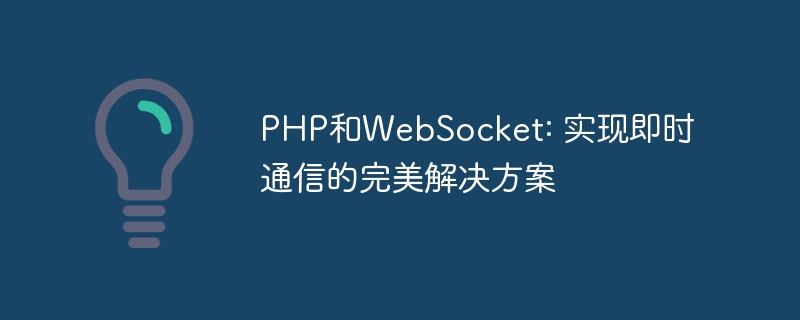Home >Backend Development >PHP Tutorial >PHP and WebSocket: the perfect solution for instant communication
PHP and WebSocket: the perfect solution for instant communication
- WBOYWBOYWBOYWBOYWBOYWBOYWBOYWBOYWBOYWBOYWBOYWBOYWBOriginal
- 2023-12-17 16:35:291557browse

With the rapid development of the Internet, more and more applications need to implement instant messaging functions, such as online chat, real-time data monitoring, etc. The traditional HTTP protocol is not suitable for this scenario because it is based on request/response, and the client must continuously send requests to the server to obtain the latest data, which brings a lot of overhead and delay.
To solve this problem, WebSocket technology comes. WebSocket can establish a two-way communication channel between the client and the server, so that both parties can transmit data at any time and do not need to care about the request/response process. PHP is also a very popular server-side language that can easily implement WebSocket functions.
This article will briefly introduce the principles and implementation methods of WebSocket, as well as the perfect solution for implementing WebSocket using PHP, and attach specific code examples to help everyone gain a deeper understanding of WebSocket technology.
The principle and implementation of WebSocket
WebSocket is a communication protocol based on the TCP protocol, which can establish a two-way communication channel between the client and the server to achieve real-time communication functions. The main features of the WebSocket protocol include the following aspects:
- Use HTTP protocol upgrade handshake
Before establishing a WebSocket connection between the client and the server, the HTTP protocol is required upgrade handshake process. This process is similar to the HTTP handshake process, but the protocol will change from HTTP to WebSocket after upgrading the handshake.
- Support full-duplex communication
The communication mode of WebSocket is full-duplex, which means that the client and the server can send and receive data at the same time. Need to wait for the request response process like HTTP.
- Support binary data transmission
WebSocket not only supports the transmission of text data, but also supports the transmission of binary data, which provides convenience for some applications that need to transmit binary data.
When implementing the WebSocket function, there are two common ways:
- Using the WebSocket server
Using the WebSocket server requires installing the WebSocket server on the server , use the WebSocket API provided by it for development. This method requires professional technology for configuration and maintenance, so the development cost is high.
- Use PHP to implement WebSocket
Using PHP language to implement WebSocket is relatively simple. You only need to write WebSocket related code on the server side to achieve real-time communication functions. This method is relatively low in development cost and maintenance difficulty, so it is widely used.
PHP is the perfect solution to implement WebSocket
When using PHP to implement WebSocket functions, you can use PHP's Swoole extension library. Swoole is a PHP extension library with excellent performance and powerful functions. It not only supports the implementation of WebSocket, but also provides support for HTTP, TCP and UDP communication protocols. Below we introduce in detail how to use the Swoole extension library to implement the WebSocket function.
- Installing Swoole
Before using the Swoole extension library, you need to install it first. It is recommended to use the PECL tool for installation. The specific command is as follows:
$ pecl install swoole
After the installation is completed, you need to add the following configuration to the PHP configuration file:
extension=swoole.so
- Implement WebSocket server
Implementing the WebSocket server in PHP requires the following steps:
- Create the WebSocket server object
- Listen to the WebSocket server port
- Handle connection events
- Handling message events
- Handling closing events
The following is a code example of using Swoole to implement a WebSocket server:
<?php
// 创建 WebSocket 服务器对象
$server = new SwooleWebsocketServer("0.0.0.0", 9501);
// 监听 WebSocket 服务器端口
$server->on('open', function (SwooleWebsocketServer $server, $request) {
echo "client {$request->fd} connected
";
});
// 处理消息事件
$server->on('message', function (SwooleWebsocketServer $server, $frame) {
echo "receive message from client: {$frame->data}
";
$server->push($frame->fd, "server received: {$frame->data}");
});
// 处理关闭事件
$server->on('close', function (SwooleWebsocketServer $server, $fd) {
echo "client {$fd} closed
";
});
// 启动 WebSocket 服务器
$server->start();The above code implements a simple The WebSocket server includes related logic such as listening for connection events, processing message events, and processing closing events.
- Implement WebSocket client
When using WebSocket for real-time communication, you need to write WebSocket client code on the client side. The following is a code example of using JavaScript to implement a WebSocket client:
// 创建 WebSocket 对象
var ws = new WebSocket("ws://127.0.0.1:9501");
// 监听连接事件
ws.onopen = function() {
console.log("websocket connected");
};
// 监听消息事件
ws.onmessage = function(e) {
console.log("receive message from server: " + e.data);
};
// 发送消息
ws.send("hello world");The above code implements a simple WebSocket client, including related logic such as listening for connection events, processing message events, and sending messages.
In summary, using PHP and WebSocket technology to implement real-time communication functions has the advantages of simplicity, efficiency, and scalability. The emergence of the Swoole extension library brings a more convenient and faster development experience. Applications that need to implement real-time communication functions can try to use this technology to improve user experience.
The above is the detailed content of PHP and WebSocket: the perfect solution for instant communication. For more information, please follow other related articles on the PHP Chinese website!

